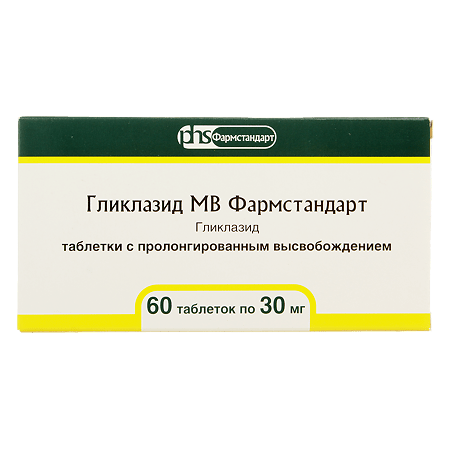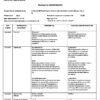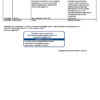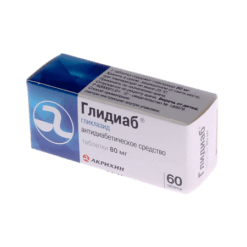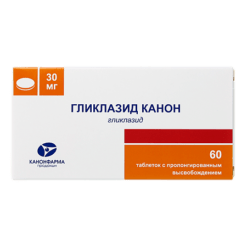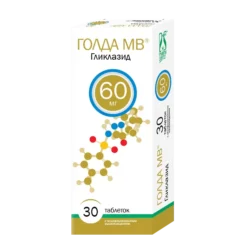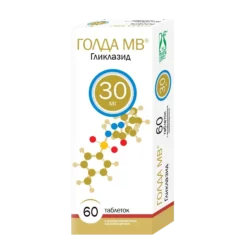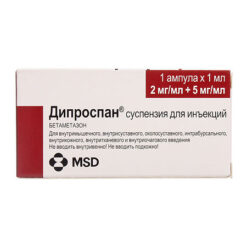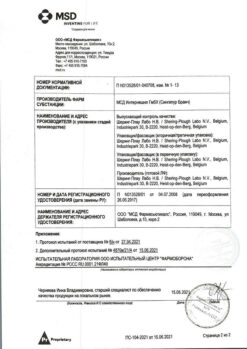No products in the cart.
Gliklazid MB Pharmstandard, 30 mg 60 pcs
€6.12 €5.44
Description
Type 2 diabetes
Type 2 diabetes mellitus in combination with diet therapy when diet and physical activity are not effective enough.
Active ingredient
Active ingredient
Composition
Composition
Active substance:
Glyclazid – 30 mg;
Associates:
Hypromellose (Metocel K 100 LV CR Premium),
silicon dioxide colloid (aerosil),
calcium stearate,
talc,
lactose monohydrate (tabletose 80).
How to take, the dosage
How to take, the dosage
Gliclazide MB modified-release tablets 30 mg are taken orally once daily with breakfast. For patients who have not previously received treatment, the initial dose is 30 mg (including those over 65 years). Then the dose is adjusted individually until the desired therapeutic effect is achieved.
The dose should be adjusted according to the blood glucose level after the start of treatment. Each subsequent dose change may be undertaken after at least a two-week period. Daily dose may vary from 30 mg (1 tablet) to 90-120 mg (3-4 tablets). The daily dose should not exceed 120 mg (4 tablets).
Gliclazide MB can substitute for gliclazide tablets with normal release (80 mg) in doses of 1 to 4 tablets per day. If one or more doses of the drug are missed, the higher dose cannot be taken at the next dose (the next day).
When replacing another hypoglycemic drug with Gliclazide MB 30 mg tablets, no transition time is required. You must first complete the daily dose of the other drug and only start taking this drug the next day.
If a patient has previously received therapy with sulfonylureas with a longer half-life, close monitoring (blood glucose control) is required for 1-2 weeks to avoid hypoglycemia as a consequence of residual effects of previous therapy.
The tablets Gliclazide MB can be used in combination with biguanides, alpha-glucosidase inhibitors or insulin.
Patients with mild to moderate renal insufficiency are prescribed the drug in the same doses as patients with normal renal function. In severe renal failure tablets Gliklazid MB are contraindicated.
Patients at risk of hypoglycemia
In patients at risk of hypoglycemia (insufficient or unbalanced nutrition; severe or poorly compensated endocrine disorders – pituitary and adrenal insufficiency, hypothyroidism; discontinuation of GCS after long-term use and/or high doses; severe cardiovascular diseases (severe coronary heart disease, severe carotid atherosclerosis, widespread atherosclerosis) a minimum dose (30 mg) of GliClazide MB is recommended.
Interaction
Interaction
Gliclazide increases the effect of anticoagulants (warfarin), correction of the anticoagulant dose may be required.
Miconazole (when administered systemically and when using the gel on the oral mucosa) increases the hypoglycemic effect of the drug (possible development of hypoglycemia up to the state of coma).
Phenylbutazone (systemic administration) increases the hypoglycemic effect of the drug (displaces it from binding to plasma proteins and/or slows excretion from the body), it is necessary to control blood glucose and adjust the dose of gliclazide, both during the administration of phenylbutazone and after its withdrawal.
Ethanol and ethanol-containing drugs increase hypoglycemia by inhibiting compensatory responses and may contribute to the development of hypoglycemic coma.
. When concomitantly administered with other hypoglycemic drugs (insulin, acarbose, biguanides), beta-adrenoblockers, fluconazole, angiotensin-converting enzyme inhibitors (captopril, enalapril), H2-histamine receptor blockers (cimetidine), monoamine oxidase inhibitors, sulfonamides and nonsteroidal anti-inflammatory drugs (NSAIDs) – increased hypoglycemic effect and risk of hypoglycemia.
Danazol – diabetogenic effect. Blood glucose levels should be monitored and the dose of gliclazide corrected, both during danazolol administration and after its withdrawal.
Chlorpromazine in high doses (more than 100 mg/day) increases blood glucose levels, reducing insulin secretion. Blood glucose control and gliclazide dose adjustment is necessary, both during chlorpromazine administration and after its withdrawal
GCS (systemic, intraarticular, external, rectal use) increase blood glucose with possible development of ketoacidosis (reduced carbohydrate tolerance). Blood glucose control and gliclazide dose adjustment are necessary, both during GCS intake and after their withdrawal.
Ritodrine, salbutamol, terbutaline (intravenous administration) – increase blood glucose. It is recommended to control blood glucose and, if necessary, transfer the patient to insulin therapy.
Special Instructions
Special Instructions
Treatment with Gliclazide MB tablets is carried out only in combination with a low-calorie, low-carbohydrate diet. Blood glucose content should be monitored regularly on an empty stomach and after meals, especially in the first days of treatment with the drug.
The tablets Gliclazide MB may only be indicated in patients on a regular diet, which must include breakfast and ensure an adequate intake of carbohydrates.
When prescribing the drug, it should be noted that hypoglycemia may develop due to sulfonylurea derivatives, and in some cases it may be severe and prolonged, requiring hospitalization and glucose administration for several days. Hypoglycemia more often develops with a low-calorie diet, after prolonged or vigorous exercise, after drinking alcohol or while taking several hypoglycemic drugs simultaneously.
In order to avoid the development of hypoglycemia, careful and individualized dose selection is necessary, as well as providing the patient with complete information about the proposed treatment.
In case of physical and emotional overexertion, with changes in diet, it is necessary to adjust the dose of Gliklazid MB tablets.
Particularly sensitive to the action of hypoglycemic drugs: the elderly; patients who do not receive a balanced diet, with a general weakened state; patients suffering from pituitary-adrenal insufficiency.
Beta-adrenoblockers, clonidine, reserpine, guanethidine may mask the clinical manifestations of hypoglycemia. Patients should be warned about the increased risk of hypoglycemia in cases of ethanol, NSAIDs, starvation.
In case of ethanol (alcohol) intake, development of disulfiram-like syndrome (abdominal pain, nausea, vomiting, headache) is also possible.
Major surgical interventions and trauma, extensive burns, infectious diseases with febrile syndrome may require withdrawal of oral hypoglycemic drugs and prescription of insulin therapy. Secondary drug resistance may develop (it is necessary to distinguish from primary resistance, in which the drug does not produce the expected clinical effect the first time it is prescribed).
During therapy with Gliclazid MB the patient should avoid alcohol and/or products containing ethanol and food.
During treatment with Gliklazid MB tablets the patient’s blood glucose and glycosylated hemoglobin levels, glucose content in urine should be determined regularly.
During treatment it is necessary to exercise caution when driving motor transport and engaging in other potentially hazardous activities that require increased concentration and rapid psychomotor reactions.
Contraindications
Contraindications
– hypersensitivity to gliclazide or any of the excipients of the drug, to other sulfonylurea derivatives, to sulfonamides;
– diabetes mellitus type 1;
– diabetic ketoacidosis, diabetic precoma, diabetic coma; . – severe renal and/or hepatic failure;
– pregnancy and lactation period;
– age under 18 years;
– taking miconazole;
– congenital lactose intolerance, lactase deficiency or glucose-galactose malabsorption.
It is not recommended to use the drug simultaneously in combination with phenylbutazone or danazol.
Side effects
Side effects
Hypoglycemia (in case of violation of the dosing regimen and inadequate diet): headache, increased fatigue, hunger, increased sweating, sudden weakness, palpitations, arrhythmia, increased blood pressure, drowsiness, insomnia, agitation, aggressiveness, anxiety, irritability, impaired concentration, inability to concentrate and slow reaction time, depression, visual disturbances, aphasia, tremors, paresis, sensory disturbances, dizziness, feelings of helplessness, loss of self-control, delirium, seizures, shallow breathing, bradycardia, loss of consciousness, coma.
Digestive system disorders: nausea, vomiting, diarrhea, abdominal pain, constipation (intensity of these symptoms decreases if taken with food); rarely – liver function disorders (hepatitis, cholestatic jaundice – requires discontinuation of the drug, increased activity of “liver” transaminases, alkaline phosphatase).
Hematopoietic organs: inhibition of medullary hematopoiesis (anemia, thrombocytopenia, leukopenia, granulocytopenia).
Allergic reactions: skin itching, urticaria, skin rash, including maculopapular and bullous), erythema.
Other: visual impairment.
General side effects of sulfonylurea derivatives: erythropenia, agranulocytosis, hemolytic anemia, pancytopenia, allergic vasculitis; life-threatening liver failure.
Overdose
Overdose
Symptoms: hypoglycemia, impaired consciousness, hypoglycemic coma. Treatment: if the patient is conscious, take sugar by mouth.
The development of severe hypoglycemic states accompanied by coma, seizures or other neurological disorders is possible.
If such symptoms occur, emergency medical care and immediate hospitalization is necessary.
If hypoglycemic coma is suspected or diagnosed, the patient is quickly injected intravenously with 50 ml of 40% dextrose (glucose) solution. Then a 5% solution of dextrose (glucose) is given intravenously by drip to maintain the necessary blood glucose level.
After recovery of consciousness, the patient should be given food rich in easily digestible carbohydrates (to avoid the recurrence of hypoglycemia). Close monitoring of blood glucose levels and monitoring of the patient should be done for at least 48 subsequent hours.
After this period of time, depending on the condition of the patient, the attending physician decides whether further monitoring is necessary. Dialysis is ineffective due to pronounced binding of gliclazide to plasma proteins.
Similarities
Similarities
Additional information
| Weight | 0.024 kg |
|---|---|
| Shelf life | 3 years |
| Conditions of storage | In a light-protected place at a temperature not exceeding 25 °C. |
| Manufacturer | Pharmstandard-Leksredstva, Russia |
| Medication form | sustained release tablets |
| Brand | Pharmstandard-Leksredstva |
Other forms…
Related products
Buy Gliklazid MB Pharmstandard, 30 mg 60 pcs with delivery to USA, UK, Europe and over 120 other countries.

